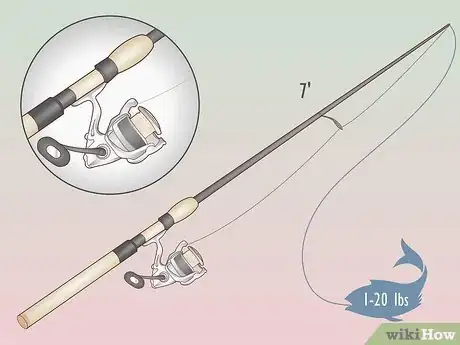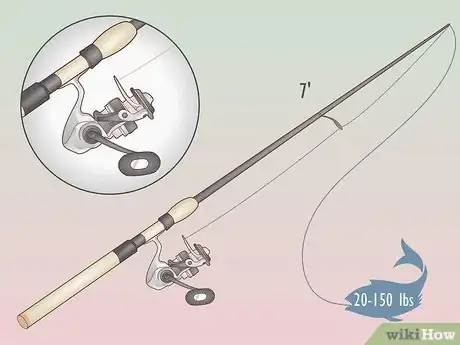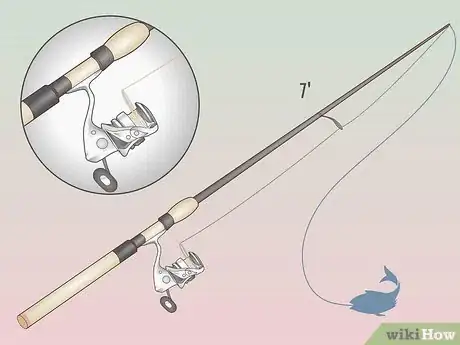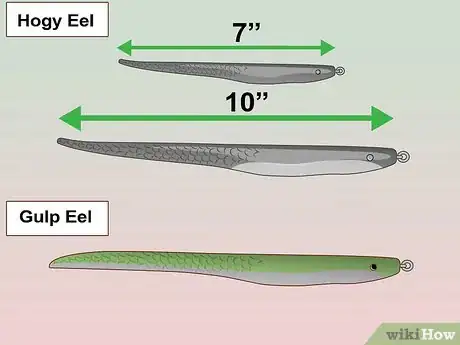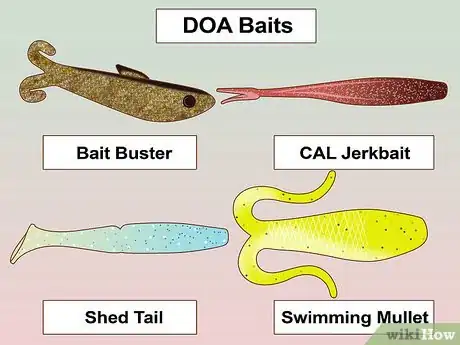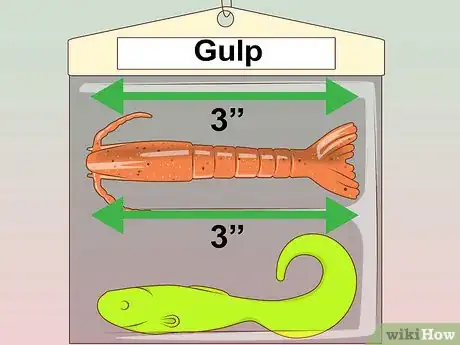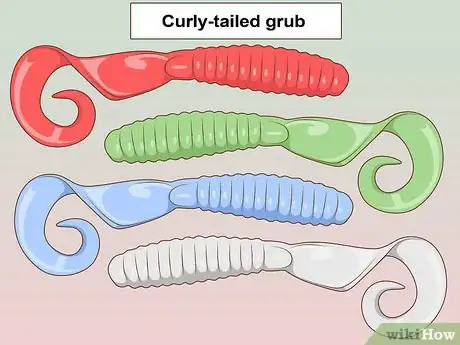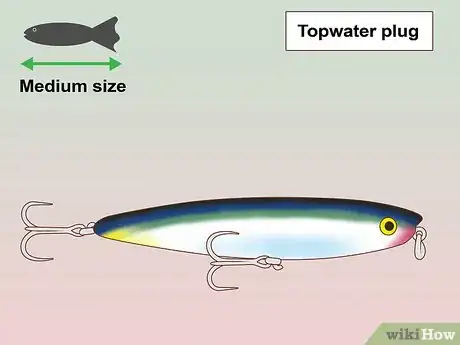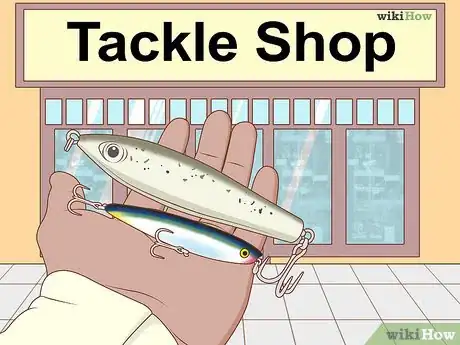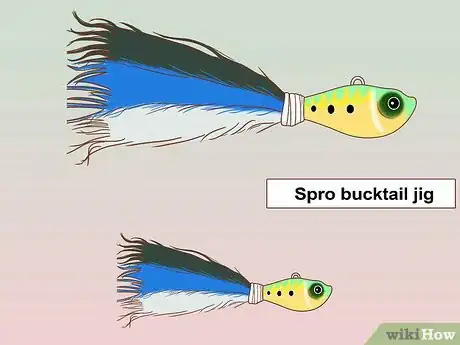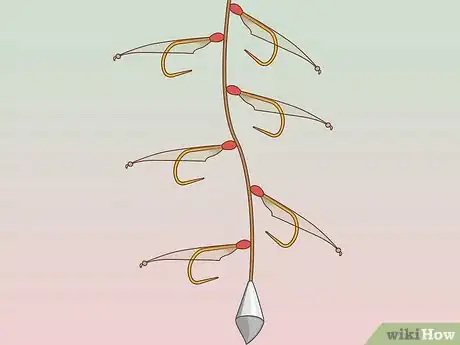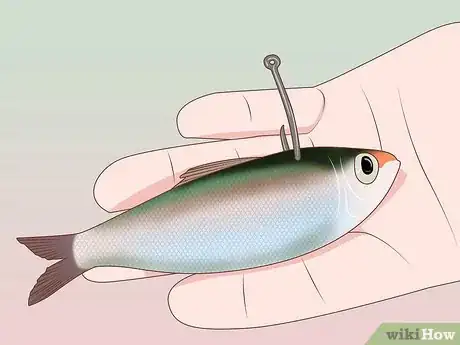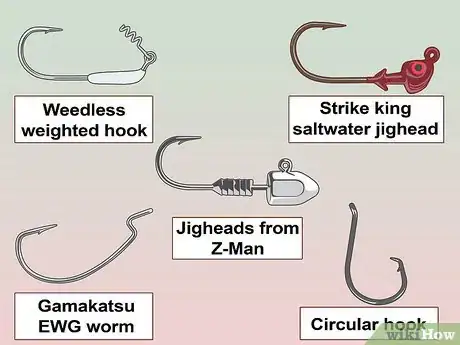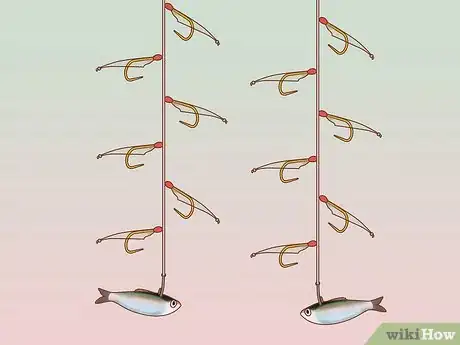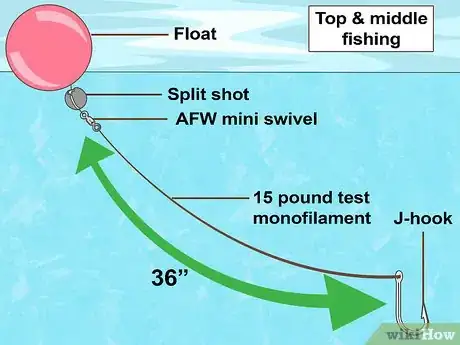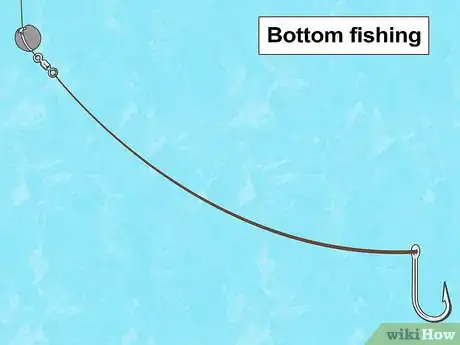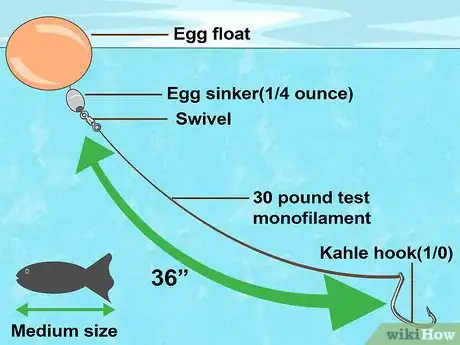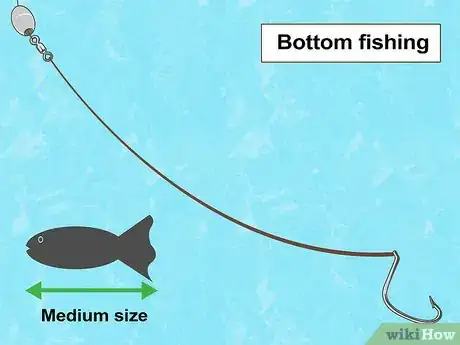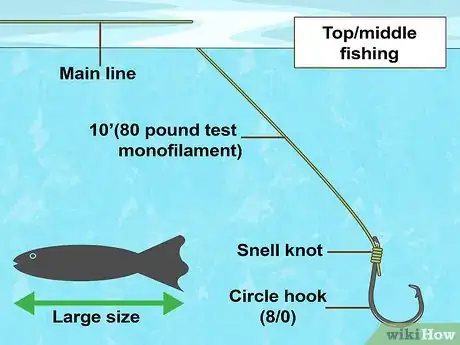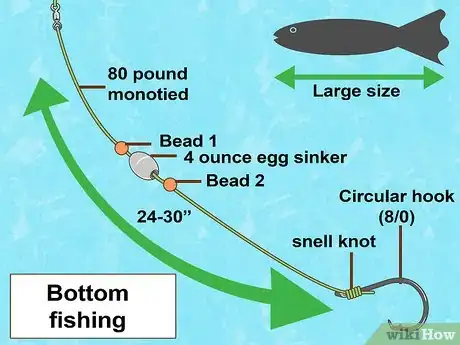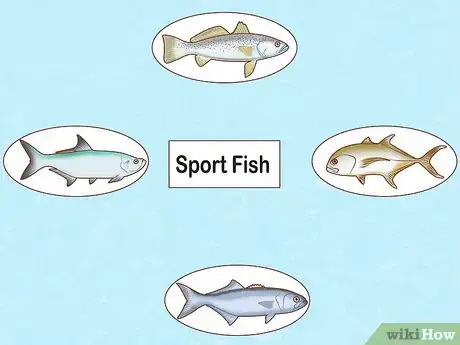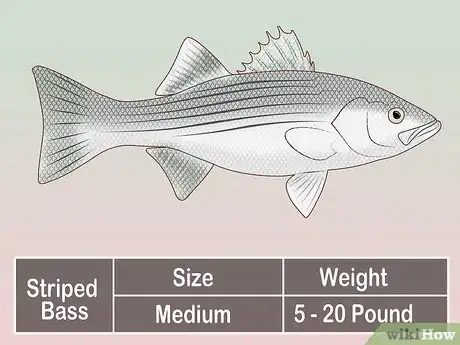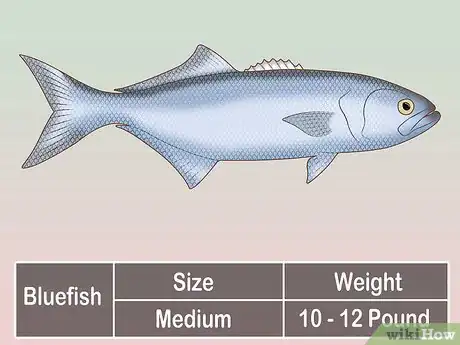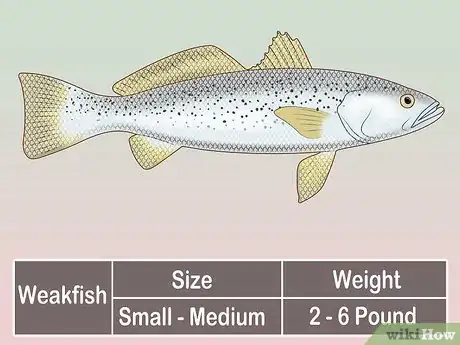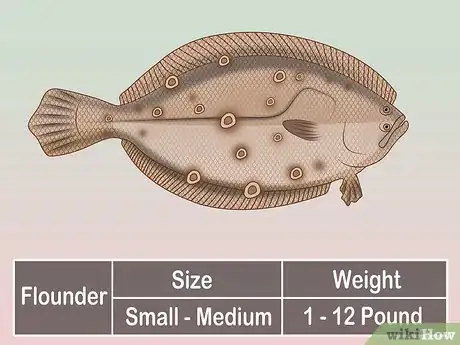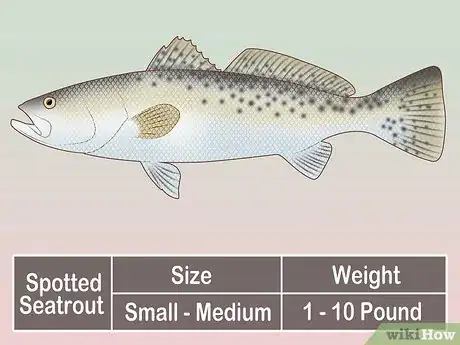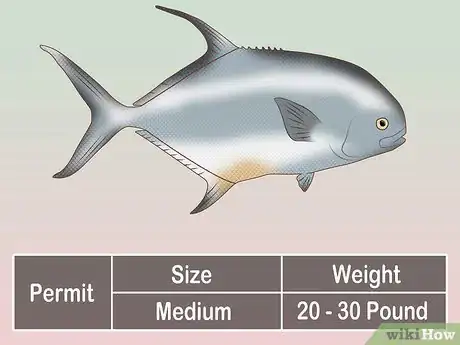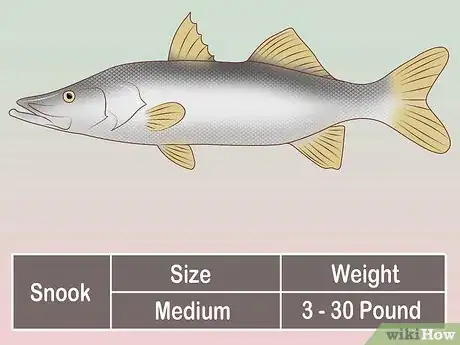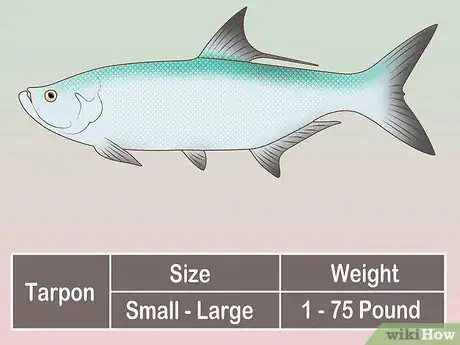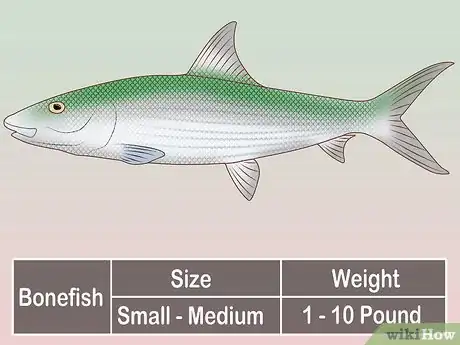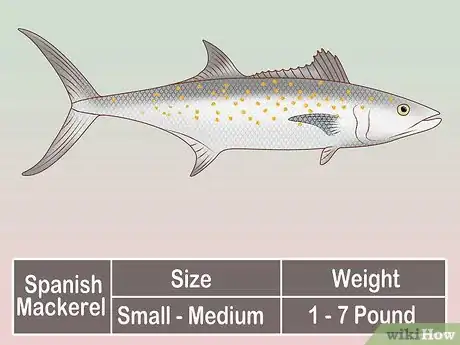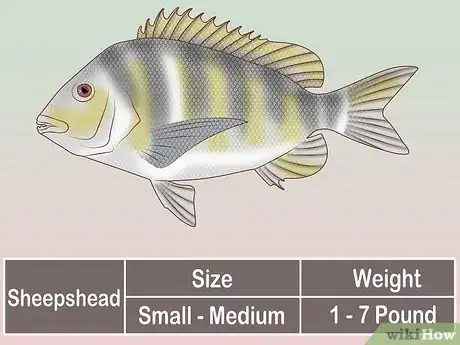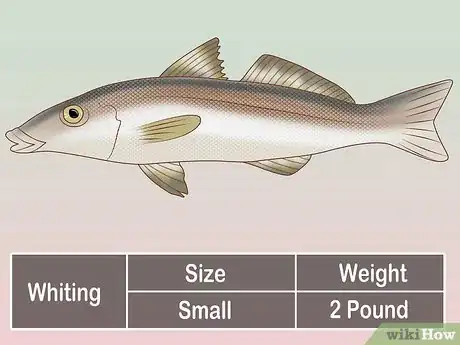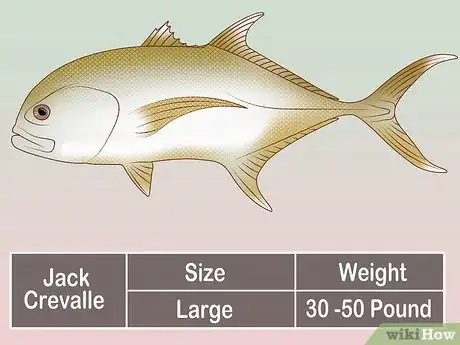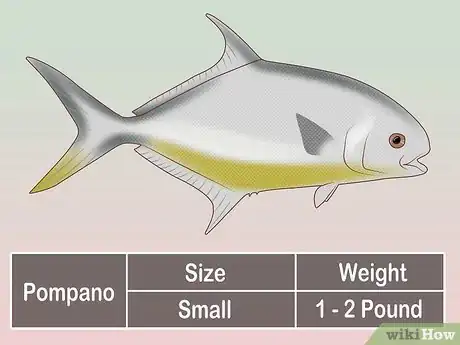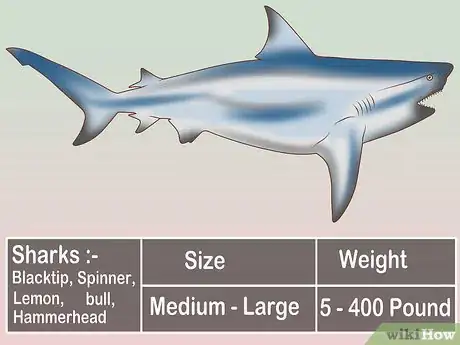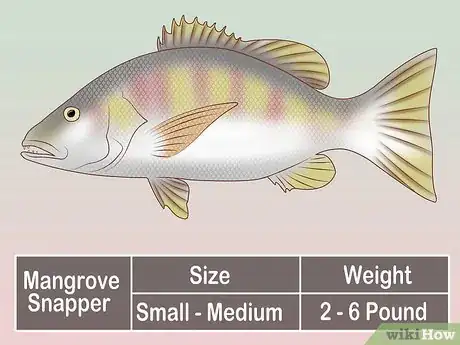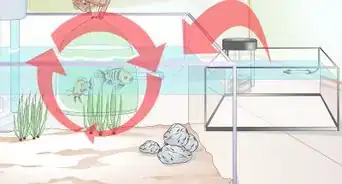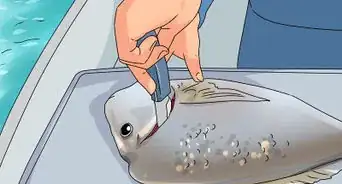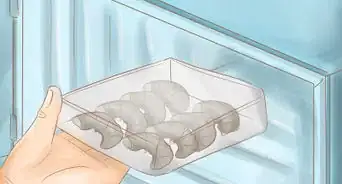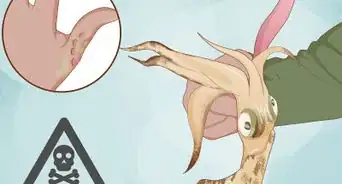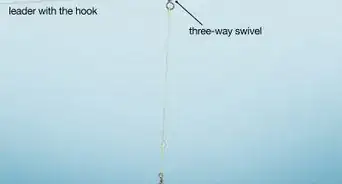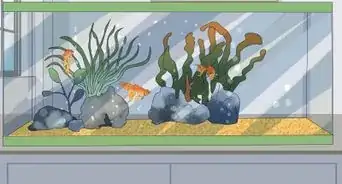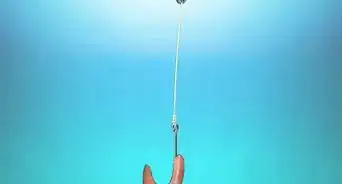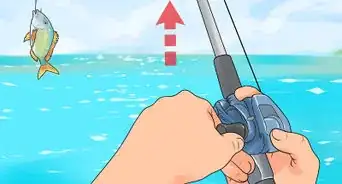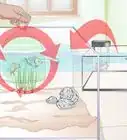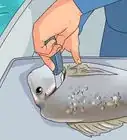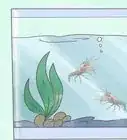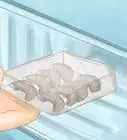wikiHow is a “wiki,” similar to Wikipedia, which means that many of our articles are co-written by multiple authors. To create this article, 20 people, some anonymous, worked to edit and improve it over time.
There are 8 references cited in this article, which can be found at the bottom of the page.
wikiHow marks an article as reader-approved once it receives enough positive feedback. In this case, several readers have written to tell us that this article was helpful to them, earning it our reader-approved status.
This article has been viewed 58,527 times.
Learn more...
This article is a tutorial on how to set up the perfect tackle box for a great day of inshore fishing. This is designed for southeastern North Carolina, but it will work anywhere near the south. It is designed for inshore fishing, which means targeting various species of fish in coastal, shallow water.
Steps
Rods, Reels, and Lines
-
1Start with a setup for your general inshore fishing. This will be used to target fish that are generally in the 1-20 pound range, such as seatrout, red and black drum, flounder, tripletail, and more. The rod should be 7’ long with a medium power rating. Match this up with a spinning reel that can hold about 200 yards of 10 pound monofilament line, and have it spooled with a quality 20 pound test braided line. An example of a great setup in this class would be a 7’ medium fast St. Croix Avid Inshore spinning rod paired up with a Shimano Stradic 4000 spooled with 20 pound test Jerry Brown solid core braid.
-
2Consider stepping it up for larger fish. If you plan on targeting larger fish while inshore, you will want to add a heavier setup to your arsenal. This can be used to target fish form 20 to about 150 pounds, such as large “bull” redfish and jacks, tarpon, cobia, and some sharks. The rod should, again, be 7’ long and carry a heavy power rating. You will want to pair this up with a spinning reel that can hold at least 300 yards of 12 pound monofilament line, and have it spooled with a quality 50 pound test braided line. An example of a great setup in this class would be a 7’ heavy fast St. Croix Avid Inshore spinning rod paired up with a Shimano Saragosa 8000 spooled with 50 pound test Jerry Brown solid core braid.Advertisement
-
3Go lighter if you're aiming for smaller fish. For targeting smaller fish, a light tackle setup is a valuable asset. Fish like whiting will not put up much of a battle on your medium or heavy outfits, but on a quality light power outfit, they just may become one of your favorite gamefish. Start with a 7’ spinning rod with a light power rating, and pair it with a reel rated to hold around 150 yards of 4 pound monofilament line. When that’s all said and done, spool the reel with a quality 10 pound test braided line. An example of a great setup in this class would be a 7’ light fast St. Croix Avid Inshore spinning rod, paired with a Shimano Stradic 1000 and spooled with 10 pound test Jerry Brown solid core braid.
Lures and Baits
-
1Start with some large plastic baits. These baits are usually used to target fish such as tarpon, bull jacks, and cobia. The most versatile baits are probably 7” and 10” Hogy Eels - pick up a pack of each of these sizes in a black and white pattern. Use the 10” size when targeting tarpon, and the 7” size for cobia and large jacks. While these can be rigged any way, two ways are the most productive - on a weighted weedless hook for pitching to fish that “suddenly” appear, and on a 1-3 ounce Jighead when blindly jigging for species like cobia. Hogy offers all of the terminal tackle needed to do this with.
- Another great large plastic is the Gulp! Eel. You can buy a pack of these in any color you prefer, as they will all generally work the same. These are best rigged with a 6/0 circle hook through the nose. To fish these, keep one rigged on a heavy rod to pitch at cobia who are passing by or suddenly appear by the boat.
-
2Get some DOA baits. DOA baits are some of the best soft plastic baits you can have. For trout, red drum, flounder, and a multitude of other species, start by stocking up on their pre-rigged 3” shrimp. There are five colors that can be considered “essentials” in this bait - clear/red flake, near clear/gold flake, glow, white, and chartreuse. These can be fished on their own, Carolina rigged, or under a popping cork (discussed later in this article).
- For larger fish like tarpon and cobia, DOA Bait Busters and Swimming Mullet are good to have. Nearly any color will work, but many have had the best success with the silver/black back colors.
- There are two other baits by DOA to consider stocking up on. First are their shad tails - these work well in natural colors and are best used when rigged on a jighead. Second is the CAL Jerkbait - this is a soft plastic jerkbait that will work well on a jighead, but is best used when fished weightless on an EWG-style worm hook, such as the type used for bass. Gamakatsu is a great brand for these hooks. Both of these baits are used on a medium setup when targeting fish in the 1 to 20 pound class.
-
3Stock up on other Gulp! Baits as well. Their 3” shrimp in natural, molting, and new penny is a killer bait for everything that swims, as is their 3” swimming mullet in white and chartreuse. These are best fished on a jighead or under a popping cork, for medium-sized inshore fish.
-
4Get a "shrimpy jig." A “secret” lure to have on hand is something known as a “shrimpy jig” - everybody has their own name for these lures, but the basic setup is a 1 to 3 ounce jighead with a plastic shrimp on the end, which has twin curly tails on it. Keep some in white and in chartreuse, and they are great for catching cobia.
-
5Get some curly-tailed grubs. These are good to have on hand. These are best fished during the winter on a jighead for medium-sized fish. Two good brands are Gotcha and Z-Man. A favorite color is clear, with many colorful flakes in it - such as red, blue, green, and silver. Chartreuse and orange grubs also work well.[1]
-
6Use topwater plugs when fishing for medium-sized fish, such as trout and red drum. There are three brands of topwater plugs that work extremely well for these fish - Heddon Super Spook Jr’s, Rapala Skitterwalks, and Bomber Badonkadonks. These are best fished with a walk-the-dog retrieve, and the best colors are any that have some orange on the belly of them. These are said to imitate dying baitfish, and they tend to work extremely well.[2]
-
7If you plan to fish for any kind of jacks, keep another type of topwater plug in with your tackle. If you are ever in a tackle shop or a store that sells any fishing tackle, check the bargain bin. If they have any large topwater plugs in there, buy some of them, and use them for jacks. The reason for this is that jacks will hit a topwater bait very hard, and often times scratch it up, chip the paint, or even break the bait entirely, and you don’t want to waste your expensive plugs on them.
-
8Consider subsurface plugs. These are another great type of hard bait when fishing for medium-sized fish. Good examples include the Bomber Long A, Mirrolure Mirrodine, and the Mirrolure 52M. Try to select colors that imitate local baitfish in your area.
-
9Consider Spro bucktail jigs. Spro bucktail jigs have become a staple in the tackle boxes of most cobia fishermen. However, when you pick up some larger ones for cobia, make sure you get some smaller ones as well - these work very well for flounder.
-
10Purchase a few sabiki rigs if you want to catch your own live bait without a net. These are long rigs which usually have six to ten droppers on them, which each have a small gold hook and a piece of mylar on them. These attract small fish to bite, and all you have to do is drop the rig to the bottom, let it sit for a while, and then bring it up - hopefully you will have caught some bait fish on it in the process.
-
11Pick live bait based on what fish you're targeting. As far as live baits go, you have a lot of choices that you can make. However, individual choices will be discussed in the section where gamefish are discussed - so that you can target the specific fish you want to catch.[3]
Terminal Tackle
-
1Remember the terminal tackle needed to fish with soft plastic baits. For fishing with plastic eels, you will want 6/0 circle hooks, as well as an assortment of 1-3 ounce jigheads and weedless weighted hooks from Hogy. You will want an assortment of smaller jigheads as well, for fishing smaller plastic baits. A good go-to are Strike King saltwater jigheads in red. These are good for all DOA, Gulp!, and Gotcha plastics - you should carry some in 1/16 ounce, ⅛ ounce, and ¼ ounce. For fishing with Z-Man plastics, you will need to buy some jigheads from Z-Man that are specially designed for them (get them in the same specifications as the Strike King ones). For fishing with any small plastic baits, jigheads made by Slayer are good. Finally, you will want some Gamakatsu EWG worm hooks for fishing with DOA’s soft plastic jerkbaits - 3/0 is a good size for this.
-
2Keep in mind the rigs needed to fish with live bait for inshore fish. To keep it simple, there are six rigs that should be used. These are designed to target small, medium, and large fish in the top, middle, and bottom of the water column.
-
3Build your light tackle rig for targeting the top and middle of the water column. Start by placing a small orange egg-shaped float on your main line. Now below this float, place a large split shot - something like a size 2 or 3 will work great. Directly below this weight, you will want to tie a very small swivel - preference goes towards AFW’s Mighty Mini swivels, as they are exceptionally strong and affordable in a very small size. At the other end of this swivel, tie on a length of 15 pound test monofilament - you should start with about 36”, but if you need to fish deeper or shallower, you can adjust. At the end of this, tie on a hook - many angler's preference is a size 2 circle hook (that is a #2, NOT a 2/0), however many people also use a #4 Aberdeen or J-hook without much trouble.
-
4To target the bottom of the water column for small fish, simply take the previous rig, and remove the float. One thing with this, is don’t make the leader length any longer than 36”. You don’t want your bait flowing too far up.
-
5To target medium sized fish in the top/middle of the water, start by placing a medium or large-sized orange egg float on your mainline. Next, slide a ¼ ounce egg sinker onto your mainline. After this, tie on a swivel (again, AFW Mighty Mini) directly below the weight. Tie a length of 30 pound test monofilament below your swivel - you should start with about 36” and go longer if you need to. On the end of your leader, tie a hook. The best all-around hook for this is a 1/0 kahle hook.
-
6To target medium sized fish on the bottom, you’ll want to start by threading an egg sinker onto your main line. ¼ ounce is usually enough, however if there is a strong current you can go up to ½ ounce. Afterwards tie on a swivel, and then 36” of 30 pound test monofilament leader. At the end, finish the rig up with a 1/0 kahle hook.
-
7To target larger fish, start by building the top/middle rig. This is usually used for free-lining live or dead baitfish - as such, the amount of terminal tackle in the rig should remain minimal. You should use 10’ of 80 pound test monofilament, tied directly to the mainline (no swivel), with an 8/0 circle hook tied onto the end with a snell knot. There are a few times when you should modify this rig - if you're fishing in areas with heavy current, try putting a size 2 or 3 split shot above the hook, to help hold the bait near the bottom. When you see fish making commotion on the surface, attach a large orange egg float about 10’ above the hook. This keeps the bait above the bottom of the water, in the likely spot where the fish are feeding. The other time you should use a float is when you are using a live fish - place the same float 6’ above the hook so that you can keep track of where the fish is swimming.
-
8To target large fish on the bottom, use a fixed sinker rig. The entire rig should be about 24-30” in length. One end has a swivel with a length of 80 pound mono tied to it. Thread on a single crimp, an orange bead, a 4 ounce egg sinker, another orange bead, and then another crimp. Close these crimps, so that your egg sinker stays in place. There should be about 12-18” between the sinker and the hook on this rig. Finish this rig off with an 8/0 circle hook, attached with a snell knot.[4]
Sport Fish You May Encounter
-
1Get to know some of the sport fish you might encounter in your fishing. Depending on where you live, these include:
-
2Look for striped bass from Maine into the Carolinas inshore. They are medium-sized fish that have gray tops, silver sides, and a white belly. They have heavy-set bodies with a large jaw, and their sides feature long dark stripes. These fish are usually found from about 5 to 20 pounds, and fish up to 50 pounds or so are sometimes caught. They have a great taste, and are very hard fighters. Try to fish a live bait rig with either a menhaden or an eel, or a subsurface plug for striped bass.[5]
-
3Look for bluefish on most of the Atlantic coast, from Maine down to Florida. They are medium-sized fish which have blue sides that gradually get whiter as they go down - the whole body has a bit of a silvery tinge to it. At the base of their pectoral fin, they typically have a large dark spot. They have a large mouth full of large sharp teeth, and a heavily forked tail. They are usually caught from less than one pound all the way up to 10-12 pounds, although from Maine to about North Carolina, they are occasionally seen up to about 20 pounds. Small bluefish taste good, although they should be directly bled and put on ice, and eaten the same day they were caught. Bluefish are some of the hardest-fighting fish to be caught inshore. A favorite way to catch them is with a topwater lure, preferably one of the “bargain bin” ones.
-
4Look for weakfish from about New York to North Carolina. These are small to medium-sized fish which are gray on top and silver on the sides and bottom - although the color can vary based on the fish’s surroundings. They have prominent canine teeth in their mouth, and their sides feature tiny black spots arranged in diagonal lines. They are usually caught at about 2 or 3 pounds in weight, but fish up to 6 pounds or so are occasionally caught. They taste pretty good, and on light tackle they are pretty fun to catch. Try to use a live bait rig with a menhaden or croaker, or a jig - either a bucktail, or a jighead with a soft plastic trailer.[6]
-
5Look for black drum from about New York to Florida. Juveniles have white or gray sides with black vertical stripes, while adults are a solid brownish-black color. Black drum of all sizes have barbels on the chin. Juveniles are normally caught from 1 to 10 pounds, however larger adults are often caught up to 50 pounds. Occasionally, fish up to about 80 pounds are found and caught. Drum under 10 pounds taste very good, but larger ones not so much. They fight hard, although this is mostly due to their size. Artificials don’t work well for them - a preferred method is an appropriately-sized bottom rig with a blue crab or a large shrimp on it.
-
6Look for flounder of various species from Maine to Florida, although the largest flounder are typically found from Massachusetts to Georgia. Flounder have both eyes on either the left or the right side of their face, and are considered flatfish. Their descriptions vary by species, but generally they are brownish in color with or without spots, although their color changes based on the bottom they are sitting on. Flounder are usually caught from about 1 to 4 pounds, although occasionally larger species are caught at 10-12 pounds. Flounder taste very good, no matter the species. Smaller flounder are only fun on light tackle, although larger flounder are usually pretty strong. Try to fish a jighead with a soft plastic trailer, however bottom rigs with live bait work very well for flounder - the best baits include killifish and mullet, but they will eat shrimp, bloodworms, or menhaden as well.
-
7Look for redfish from about New York to Florida. Juvenile redfish are usually pink, and gradually get redder and redder - when they are adults, they are usually a bit more bronze than red. Redfish typically have a large spot at the base of the tail, and have large, thick scales. They are usually caught from about 2 to 15 pounds, although bull redfish of 30+ pounds are not too rare. Redfish under about 10 pounds taste very good, although larger ones don’t taste as good. Redfish are very strong fighters, and are capable of making very long runs. Try to fish a subsurface plug for redfish, and if that doesn’t work then go for a bottom rig with a mullet, crab, or shrimp on it.[7]
-
8Look for spotted seatrout from New Jersey to Florida. They have a large mouth with prominent canine teeth, and are usually silver in color - although like the weakfish, their color changes based on their environment. They have a lot of black spots on their sides. They are small, usually found about 1 to 3 pounds in weight - sometimes, anglers catch fish in the 4-10 pound range though. They taste pretty good, and on light tackle they fight pretty hard. Try a live bait rig with shrimp for smaller trout, but when the larger trout are around, rig up a small live perch, croaker, pigfish, or menhaden. When you feel like using an artificial, reach for a soft plastic jerkbait, a jighead with a soft plastic trailer, or a topwater plug.
-
9Look for permit in good numbers in Florida. They are a deep, round fish with a silver color, and they have a black spot under their pectoral fin. They have large, sickle-shaped tails with no scutes. When these fish are caught, they are often founds in weights of up to 20 or 30 pounds. Small fish taste very good, but large ones don’t taste as good and should be released for other anglers to catch. Many anglers consider permit the toughest shallow-water gamefish in the world, and they are very strong, capable of making incredibly long runs and even spooling reels at times. They do not typically take artificials, so you should fish a bottom rig with a live crab - if you don’t have crabs, try going for a shrimp or a sand flea.
-
10Look for snook in Florida. They have silvery sides, yellow fins, and are usually black on top. The snout is tapered, fins and jaw are large, and their side features a full-length black stripe. They are usually caught from about 3 to 15 pounds in weight, but anglers occasionally catch 20 or 30 pound fish. They taste very good, and are another of the strongest inshore gamefish. They can make multiple long runs, they often jump, and they often try to wrap the line around structure. Try fishing for them with soft plastic shrimp, but bucktails will work as well. For live bait - shrimp, mullet, menhaden, sardines, and herring all work very well.[8]
-
11Look for tarpon from Virginia to Florida. They are very large silver fish with a green back and a dark tail. They have very large scales, large scoop-jawed mouths, and there is a streamer which comes off of the end of the dorsal fin. They can be caught from under 1 pound up to 75 pounds, and anglers sometimes catch fish of 100 pounds or more. They do not taste good at all, and should always be released. They are hard fighters, targeted for their large frequent jumps. Fishing for them with artificial lures doesn’t always offer a good hookup ratio - so it's recommended to use a natural bait. Mullet, crabs, and shrimp top the list of natural baits.
-
12Look for bonefish in Florida. They are silvery fish with prominent scales and dark green backs. They have forked tails and pointed heads, and are very thick-bodied, muscular fish. They are usually caught from about 1 to 4 pounds, but they are occasionally caught up to about 10 pounds. They do not taste good, and are worth far more alive than dead. In deep water they are pretty strong, but on the flats, they make incredibly long runs which can spool a reel if not careful. Fishing smaller skimmer-style jigs works well for bonefish, but for consistency, try using a natural bait like shrimp or small crabs.
-
13Look for spanish mackerel from Maryland to Florida - although in warm months they go as far north as Massachusetts. They are deep-bodied fish with dark backs and silver sides with many yellow pots. They are elongated fish that have large mouths full of sharp teeth. They are usually caught from 1 to 5 pounds, but sometimes an angler gets lucky and can catch a fish up to 7 pounds or so. Fresh spanish mackerel are tasty, and on light tackle they are great fun to catch. Try fishing a small, silver artificial lure worked quickly through a school to catch them - although sometimes a live bait rig with shrimp or a small live baitfish will work. A last-ditch attempt is a jighead with a soft plastic trailer.
-
14Look for sheepshead from New York to Florida. They have heavy-set bodies, with vertical black stripes against a gray, white, or yellow body. They have spines on the dorsal and anal fins, and a mouth filled with large protruding teeth, almost like a sheep’s. They are typically caught from about 1 to 7 pounds, although anglers sometimes catch 10 pound fish. Since they mostly eat shellfish, they taste very good - and on light tackle, they use their flat shape to their advantage, and are very strong. Many anglers love a live fiddler crab for sheepshead, but live shrimp also work well.
-
15Look for ladyfish in Florida, Georgia, and the Carolinas. They are silver, with a green back and a large dorsal fin. They have a large scooping jaw and a forked tail, similar to a tarpon. They are usually one pound or less, although on special occasions, an angler will catch one up to about 4 pounds or so. They do not taste good at all, but for their size they are incredible fighters. They frequently jump, and make long runs that can come close to spooling a reel. They aren’t picky, so try to fish a jighead with a soft plastic trailer or a small bucktail jig for them - they are often taken on live bait rigs as well, usually rigged up with live shrimp, mullet, or other small baitfish.
-
16Look for croaker from Massachusetts to Florida. They are usually silver or gold, and may have wavy stripes towards the top of their body. They have small barbels on their chin, and are similar in form to a redfish. South of North Carolina, they are usually caught up to a pound, with 3 pound fish being taken every once in awhile. From North Carolina northward, they are often caught up to 3 pounds, and occasionally an angler will catch a nearly 5 pound fish. The preferred method of hunting these fish is a light bottom rig with a sand flea, shrimp, crab, bloodworm, or mud minnow.
-
17Look for whiting from about New Jersey to Florida, depending on the species. They can be brown, black, or silver in color, with or without black or yellowish stripes. They have barbels on their chin, and typically have tall dorsal fins. They are usually caught under one pound, although they are occasionally taken to about 2 pounds. They taste alright, and on light tackle they are pretty strong. A light bottom rig with squid, glass minnows, sand fleas, or shrimp is usually preferred - but if possible, it's fun to sight-fish them with a very small jighead and a small soft plastic trailer.
-
18Look for jack crevalle in the Carolinas, Georgia, and Florida. They have deep, compressed bodies with blunt heads and a black spot on the gill cover. Their bodies are usually a dirty yellow color with white on the belly, and they have hard scutes leading towards their sickle-shaped tail. They range greatly in size, from under one pound to about 30 pounds - although a lucky angler may catch a 50 pound fish at times. They don’t taste very well, but they are generally considered the toughest fish that are readily caught inshore. They usually start the fight with a long run, and once they see the boat they typically make many smaller runs and will not hesitate to circle the boat or swim straight down in resistance. Many anglers love to fish a large topwater plug for them, but if that doesn’t work then tie on a jig of some sort. Live bait offerings include a large live mullet for larger jacks and smaller mullet or shrimp for smaller fish.
-
19Look for pompano in the Carolinas, Georgia, and Florida. They are round fish with a silver coloration and a yellow belly. They have a black dorsal fin with yellow fins everywhere else. They are usually caught to about 1 pound, although lucky anglers may catch a few 2-pounders on a good day. They are some of the best-tasting inshore fish, and they fight like a jack crevalle of equal size, with even longer and faster runs. Bottom rigs with sand fleas and shrimp produce lots of fish, but in a pinch you can also use crabs, clams, or even small minnows.
-
20Look for sharks such as blacktip, spinner, or Bonnethead sharks - although larger lemon, bull, and hammerhead sharks can be found inshore at certain times of the year. While these sharks can be found from about Massachusetts southward, the best places to target these sharks are in the Carolinas, Georgia, and Florida - with Florida being the “Shark Capital” of the United States. Blacktip and spinner sharks are typical-looking sharks with a gray coloration, and black tips on the fins. Bonnetheads and hammerheads have the typical shark body, except with their prominent hammer-shaped head - bonnetheads are more circular or shovel-shaped in the head than other species. Lemon sharks also have the typical shark look to them, although they are usually brown with a yellow belly - they have short dorsal fins and large pectorals. Bull sharks once again have the typical shark build, although with a shorter, wider snout and a large dorsal fin. Blacktip and spinner sharks are typically found in the 5-50 pound range, bonnetheads reach about 2-5 pounds, bulls and lemons in the 100-400 pound range, and hammerheads commonly exceeding 500 pounds in weight in certain parts of Florida.
- None of these sharks taste all that well and should be released. While the size of larger sharks makes them formidable opponents (and not likely to be brought in on your inshore tackle), smaller sharks are great fun to catch on medium spinning tackle. Plenty of fish-based baits will catch sharks. A personal favorite is a chunk or stingray, a large menhaden, or a whole ladyfish - but plenty of baits will work, such as a chunk of barracuda/bonito/albacore/jack/bluefish, or a whole large mullet.
-
21Look for mangrove snapper in the Carolinas, Georgia, and Florida. They have the typical shape of a snapper, with a gray or olive green coloration and a white belly - they usually have a reddish tinge to them. There is a black line running from the shout to the dorsal fin, which darkens when the fish gets excited due to feeding. Inshore, these fish are usually only caught up to about 12” in length - although very occasionally, a larger fish from a deep reef will come inshore, and an angler will have a shot at a fish in the 2-6 pound class. Inshore-sized fish are very good tasting, and larger fish are still tasty but not as good. Mangroves usually make a strong run when hooked, and will fight all the way until they are brought into the boat. They can be caught on artificials, but live bait is much more hassle-free for them. They're easy to catch them on a small float rig with a shrimp, glass minnow, crab, sardine, or even a ballyhoo chunk.
Community Q&A
-
QuestionThe tarpons won't eat my shrimp; how can I lure them?
 Community AnswerSpot the tarpon and get ahead of it quietly. Then, put your shrimp down-current of the tarpon (bait fish and shrimp do not go against the current, but rather go with the flow of the water). Use the twitch-twitch-pause method, and you can catch the tarpon.
Community AnswerSpot the tarpon and get ahead of it quietly. Then, put your shrimp down-current of the tarpon (bait fish and shrimp do not go against the current, but rather go with the flow of the water). Use the twitch-twitch-pause method, and you can catch the tarpon. -
QuestionFishing with a 7'0 Ugly Stik in Cyprus. Off the shore and in a dam reservoir. What's the best way to rig up dead small 3-5" whole fish for suitability?
 Caden KaufmanCommunity AnswerTry the fish finder rig for salt. It will catch fresh water monsters as well. The internet has many tutorials on this rig.
Caden KaufmanCommunity AnswerTry the fish finder rig for salt. It will catch fresh water monsters as well. The internet has many tutorials on this rig.
Warnings
- Be careful of different fish out there. Bull sharks can be encountered in brackish marshes. Stingrays will "harpoon" waders, and can inflict serious injuries. Pinfish have sharp dorsal spines. Drum have crushing mouths. Sheepshead have crunching teeth. Bluefish have very sharp teeth. Pufferfish are poisonous to eat. Cobia go crazy when brought into boats. Crabs have sharp claws.⧼thumbs_response⧽
- Check seasons, limits, and tackle restrictions on all species of inshore fish in your area, if you plan on keeping fish. Not obeying size limits when keeping fish will land you in a lot of trouble.⧼thumbs_response⧽
- Knives can be dangerous too. Use common sense when using knives.⧼thumbs_response⧽
- Be careful where you fish. Fishing in no-fish zones or on private docks will land you in big trouble.⧼thumbs_response⧽
References
- ↑ https://www.outdoorlife.com/articles/fishing/2007/09/ultimate-guide-jigs-and-grubs/
- ↑ https://theknow.denverpost.com/2018/06/26/topwater-lure-fishing-guide/188203/
- ↑ https://www.fix.com/blog/bait-versus-lures-which-is-best/
- ↑ https://georgepoveromo.com/content.php?pid=22
- ↑ https://www.wildlife.ca.gov/fishing/inland/striped-bass#35540373-angling
- ↑ http://dnr.maryland.gov/fisheries/Pages/Fish-Facts.aspx?fishname=Weakfish
- ↑ https://tpwd.texas.gov/huntwild/wild/species/reddrum/
- ↑ https://myfwc.com/wildlifehabitats/profiles/saltwater/snook/snook/
